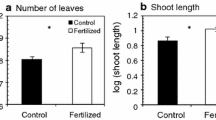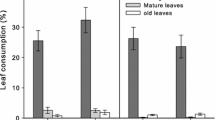Abstract
The rising level of atmospheric CO2 has stimulated several recent studies attempting to predict the effects of increased CO2 on ecological communities. However, most of these studies have been conducted in the benign conditions of the laboratory and in the absence of herbivores. In the current study, we utilized large octagonal chambers, which enclosed portions of an intact scrub-oak community to investigate the interactive effects of CO2 and insect herbivory on myrtle oak, Quercus myrtifolia. Specifically, we assessed the effects of ambient and elevated CO2 (2× current concentrations) on percent foliar nitrogen, C:N ratio, total relative foliar tannin content, and the presence of leaf damage caused by leaf mining and leaf chewing insects that feed on myrtle oak. Total foliar N declined and C:N ratios increased significantly in oaks in elevated CO2 chambers. The percentages of leaves damaged by either leafminers or leaf chewers tended to be lower in elevated compared to ambient chambers, but they co-occurred on leaves less than expected, regardless of CO2 treatment. Leaves that had been either mined or chewed exhibited a similar wounding or defensive response; they had an average of 25 and 21% higher protein binding ability, which is correlated with tannin concentration, compared to nondamaged control leaves, respectively. While the protein-binding ability (expressed as total percent tannin) of leaves from elevated CO2 was slightly higher than from leaves grown in ambient chambers, this difference was not significant.
Similar content being viewed by others
REFERENCES
Agrell, J., McDonald, E. P., and Lindroth, R. L. 2000. Effects of CO2 and light on tree phytochemistry and insect performance. Oikos 88:259–272.
Berenbaum, M. and Seigler, D. 1992. Biochemicals: Engineering problems for natural selection, pp. 89–121, in B. D. Roitberg and M. B. Isman (eds.). Insect Chemical Ecology. Chapman and Hall, New York.
Bernays, E. A. and Chapman, R. F. 1994. Host-Plant Selection by Phytophagous Insects. Chapman and Hall, New York.
Bryant, J. P., Chapin, F. S., and Klein, D. R. 1983. Carbon/nutrient balance of boreal plants in relation to vertebrate herbivory. Oikos 40:357–368.
Clark, D. A., Piper, S. C., Keeling, C. D., and Clark, D. B. 2003. Tropical rain forest tree growth and atmospheric carbon dynamics linked to interannual temperature variation during 1984–2000. Proc. Natl. Acad. Sci. U.S.A. 100:5852–5857.
Cork, S. J. and Krockenberger, A. K. 1991. Methods and pitfalls of extracting condensed tannins and other phenolics from plants: Insights from investigations on Eucalyptus leaves. J. Chem. Ecol. 17:123–134.
Crowley, T. J. and Berner, R. A. 2001. CO2 and climate change. Science 292:870–872.
Drury, S. J., Good, J. E. G., Perrins, C. M., Buse, A., and Kaye, T. 1998. The effects of increasing CO2 and temperature on oak leaf palatability and the implications for herbivorous insects. Global Change Biol. 4:55–61.
Fajer, E. P., Bowers, M. D., and Bazzaz, F. A. 1991. The effects of enriched CO2 atmospheres on the buckeye butterfly, Junonia, coenia. Ecology 75:1198–1200.
Feeny, P. P. 1969. Inhibitory effects of oak leaf tannins on the hydrolysis of proteins by trypsin. Phytochemistry 8:2119–2126.
Feeny, P. P. 1970a. Effect of oak leaf tannins on larval growth of the winter moth Operophtera brumata. J. Insect Physiol. 14:805–817.
Feeny, P. P. 1970b. Seasonal changes in oak leaf tannins and nutrients as a cause of spring feeding by winter moth caterpillars. Ecology 51:565–581.
Feeny, P. P. and Bostock, H. 1968. Seasonal changes in the tannin content of oak leaves. Phytochemistry 7:871–880.
Flower, B. 1999. Warming without high CO2? Nature 399:313–314.
Hagerman, A. E. 1987. Radial diffusion method for determining tannin in plant extracts. J. Chem. Ecol. 13:437–449.
Hagerman, A. E. 1988. Extraction of tannin from fresh and preserved leaves. J. Chem. Ecol. 14:453–461.
Harborne, J. B. 1988. Introduction to Ecological Biochemistry, 4th edn. Academic Press, London.
Hartley, S. E., Jones, C. G., Couper, G. C., and Jones, T. H. 2000. Biosynthesis of plant phenolic compounds in elevated atmospheric CO2. Global Change Biol. 6:497–506.
He, J., Bazzaz, F. A., and Schmid, B. 2002. Interactive effects of diversity, nutrients and elevated CO2 on experimental plant communities. Oikos 97:337–348.
Heagle, A. S. 2003. Influence of elevated carbon dioxide on interactions between Frankliniella Occidentalis and Trifolium repens. Environ. Entomol. 32:421–424.
Heijmans, M. P. D., Klees, H., and Berendse, F. 2002. Competition between Sphagnum magellanicum and Eriophorum angustifolium as affected by raised CO2 and increased N deposition. Oikos 97:415–425.
Houghton, J. T., Meira Filho, L. G., Callander, B. A., Harris, N., Kattenberg, A., and Maskell, K. 1996. Climate Change 1995. The Science of Climate Change. Cambridge University Press, New York.
Keeling, C. D., Wharf, T. P., Wahlen, M., and Van Der Plicht, J. 1995. Interannual extremes in the rate of rise of atmospheric carbon dioxide since 1980. Nature 375:666–670.
Kopper, B. J., Jakobi, V. N., Osier, T. L., and Lindroth, R. L. 2002. Effects of paper birch condensed tannin on whitemarked tussock moth (Lepidoptera: Lymantriidae) performance. Environ. Entomol. 31:10–14.
Kraus, T. E. C., Yu, Z., Preston, C. M., Dahlgren, R. A., and Zasoski, R. J. 2003. Linking chemical reactivity and protein precipitation to structural characteristics of foliar tannins. J. Chem. Ecol. 29:703–730.
Li, J.-H., Dijkstra, P., Hinkle, C. R., Wheeler, R. M., and Drake, B. G. 1999. Photosynthetic acclimation to elevated atmospheric CO2 concentration in the Florida scrub-oak species Quercus geminata and Quercus mrytifolia growing in their native environment. Tree Physiol. 19:229–234.
Lindroth, R. L., Arteel, G. E., and Kinney, K. K. 1995. Responses of three saturnid species to paper birch grown under enriched CO2 atmospheres. Funct. Ecol. 9:306–311.
Lindroth, R. L., Kinney, K. K., and Platz, C. L. 1993. Responses of deciduous trees to elevated atmospheric CO2: Productivity, phytochemistry, and insect performance. Ecology 74:763–777.
Lindroth, R. L., Roth, S., and Nordheim, E. V. 2001. Genotypic variation in response of Quaking aspen (Populus tremuloides) to atmospheric CO2 enrichment. Oecologia 126:371–379.
Mansfield, J. L., Curtis, P. S., and Zak, D. R. 1999. Genotypic variation for condensed tannin production in trembling aspen (Populus tremuloides, Salicaceae) under elevated CO2 and in high-and low-fertility soil. Am. J. Bot. 86:1154–1159.
McDonlald, E. P., Agrell, J., and Lindroth, R. L. 1999. CO2 and light effects on deciduous trees: Foliar chemistry, and insect performance. Oecologia 119:389–399.
Mole, S. and Waterman, P. G. 1985. Stimulatory effects of tannins and cholic acid on tryptic hydrolysis of proteins: Ecological implications. Oecologia 72:137–147.
Oren, R., Ellsworth, D. L., Johnsen, K. H., Phillips, N., Ewers, B. E., Maler, C., Schafer, K. V. R., McCarthy, H., Hendrey, G., McNulty, S. G., and Katul, G. G. 2001. Soil fertility limits carbon sequestration by forest ecosystems in a CO2-enriched atmosphere. Nature 411:469–472.
Rossi, A. M. and Strong, D. R. 1991. Effects of host-plant nitrogen on the preference and performance of laboratory populations of Carneocephala floridana (Homoptera: Cicadellidae). Environ. Entomol. 20:1349–1355.
Roth, S. K. and Lindroth, R. L. 1994. Effects of CO2-mediated changes in paper birch and white pine chemistry on gypsy moth performance. Oecologia 98:133–138.
Roth, S., Lindroth, R. L., Volin, J. C., and Kruger, E. L. 1998. Enriched atmospheric CO2 and defoliation: Effects on tree chemistry and performance. Global Change Biol. 4:419–430.
Sandalow, D. B. and Bowles, I. A. 2001. Fundamentals of treaty-making on climate change. Science 292:1839–1840.
Schlesinger, W. H. and Lichter, J. 2001. Limited carbon storage in soil and litter of experimental forest plots under increased atmospheric CO2. Nature 411:466–469.
Schultz, J. C. and Baldwin, I. T. 1982. Oak leaf quality declines in response to defoliation by gypsy moth larvae. Science 217:149–151.
Stiling, P., Catell, M. V., Moon, D. C., Rossi, A. M., Hungate, B. A., Hymus, G., and Drake, B. 2002. Elevated atmospheric CO2 lowers herbivore abundance, but increases leaf abscission rates. Global Change Biol. 8:1–10.
Stiling, P., Moon, D. C., Hunter, M. D., Colson, J., Rossi, A. M., Hymus, G., and Drake, B. 2003. Elevated CO2 lowers relative absolute herbivore density across all species of a scrub-oak forest. Oecologia 134:82–87.
Stiling, P., Rossi, A. M., Hungate, B., Dijkstra, P., Hinkle, C. R., Knott, W. M., and Drake, B. 1999. Decreased leaf-miner abundance in elevated CO2: Reduced leaf quality and increased parasitoid attack. Ecol. Appl. 9:240–244.
Swain, T. 1979. Tannins and lignins, in G. A. Rosenthal and D. H. Janzen (eds.). Herbivores: Their Interaction with Secondary Plant Metabolites. Academic Press, London, pp. 657–682.
Tangley, L. 2001. High CO2 levels may give fast-growing trees an edge. Science 292:36–37.
Villalba, J. J., Provenza, F. D., and Bryant, J. P. 2002. Consequences of the interaction between nutrients and plant secondary metabolites on herbivore selectivity: Benefits or detriments for plants. Oikos 97:282–292.
Wigley, T. M. L. and Raper, S. C. B. 1992. Implications for climate and sea level of raised IPCC emission scenarios. Nature 357:293–300.
Williams, R. S., Thomas, R. B., Strain, B. R., and Lincoln, D. E. 1997. Effects of elevated CO2, soil nutrient levels, and foliage age in the performance of two generations of Neodiprion lecontei (Hymenoptera: Diprionidae) feeding on loblolly pine. Environ. Entomol. 26:201–205.
Zurer, P. 2001. Forests' role as CO2 sinks limited. Chem. Eng. News, May 28.
Author information
Authors and Affiliations
Rights and permissions
About this article
Cite this article
Rossi, A.M., Stiling, P., Moon, D.C. et al. Induced Defensive Response of Myrtle Oak to Foliar Insect Herbivory in Ambient and Elevated Co2 . J Chem Ecol 30, 1143–1152 (2004). https://doi.org/10.1023/B:JOEC.0000030268.78918.3a
Issue Date:
DOI: https://doi.org/10.1023/B:JOEC.0000030268.78918.3a




